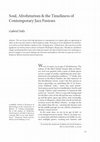Articles by Gabriel Solis
Journal of the Society for American Music, 2019
Introduction to the special issue of the Journal of the Society for American Music: Music, Indige... more Introduction to the special issue of the Journal of the Society for American Music: Music, Indigeneity, and Colonialism in the Americas

Jazz Research Journal, 2018
The opening episode of season two of the AMC series Preacher begins with a big reveal that sets i... more The opening episode of season two of the AMC series Preacher begins with a big reveal that sets in motion the season's subsequent action: God has come to earth and gone missing. The protagonists-a preacher possessed by the powerful, but amoral offspring of the illicit coupling of an angel and a demon, his contract killer girlfriend, and an Irish vampire-track the almighty to a small town strip club in East Texas he has been rumored to frequent. God is not there, mayhem ensues, and in the club's office the manager-before succumbing to a gunshot wound-tells the preacher, with a sigh, 'God didn't come for the girls, you idiot. He came…for the jazz.' The show then cuts to the club's performance space where a piano-less trio led by veteran New Orleans drummer Johnny Vidacovich offers a Coltrane-inflected, hard bop-style tune while pole dancers writhe at the edge of the screen. Jazz is here partly, it turns out, to give the showrunners an excuse to set the season in New Orleans, but it is also here for more than simple exigency. This article plumbs the place of jazz in three contemporary American television shows' soundtracks: AMC's Preacher, Showtime's I'm Dying Up Here, and F/X's Louie. Together they represent a distinct cultural phenomenon in a distinct historical moment: the embrace of jazz as a music signifying creativity and the new; hipness and the bohemian margins of polite society; and elite, left wing intellec-tualism in an America riven by hope, change, and retrenchment.

Daedalus, 2019
The rise of jazz-R&B-hip hop fusions in contemporary Los Angeles offers an opportunity to reflect... more The rise of jazz-R&B-hip hop fusions in contemporary Los Angeles offers an opportunity to reflect on the ways jazz matters to black audiences today. Drawing on recent Afrofuturist art and theory as well as on Amiri Baraka's analysis of the "changing same" in black music, this essay traces out the significance of work by artists as diverse as Kamasi Washington, Flying Lotus, Thundercat, and Robert Glasper, positing that their music tells us that jazz matters not only in itself, but also in its continuing capacity to engage in cross-genre dialogues for musicians and audiences who hear it as part of a rich continuum of African American musical expression. We are, it seems, in an age of Afrofuturism. The release of the Black Panther feature film in Febru-ary 2018 was greeted with a spate of think pieces across a range of media, explaining the term Afro-futurism for an unfamiliar audience. "T'Challa, also known as the Black Panther, the title character of the blockbuster movie, wasn't the first person to land a spaceship (or something like it) in downtown Oakland, Calif.," starts one such article. 1 Such pieces point back to bandleaders Sun Ra and George Clinton (and sometimes to Jamaican dub artist Lee "Scratch" Perry) to provide background for the film's mix of the old and the new, technology and the spirit, space-age Africa, and, eventually, a sense of diasporic culture that travels in both directions across the Black Atlantic-in ships in the sky rather than the sea-suturing the fissures rent by the middle passage, by war, and by colonial mo-dernity's many terrors. At the same time, we are in an age of poly-or even omnigenericism in music. That is, in many cases , musicians and their audiences are liable to connect multiple genres, creating new fusions, and gabriel solis is Professor of

Journal of the Polynesian Society, 2018
In the 19th century Melanesians were pejoratively labelled black by European maritime explorers (... more In the 19th century Melanesians were pejoratively labelled black by European maritime explorers (mela = black; nesia = islands).1 Emerging scholarship on the Black Paci c (Shilliam 2015; Solis 2015a, 2015b; Swan [as interviewed by Blain 2016]), a parallel to Paul Gilroy’s The Black Atlantic (1993), focuses on historical and contemporary identi cations and articulations (“a nities, a liations and collaborations” [Solis 2015b: 358]) between Oceanian and African diasporic peoples, cultures and politics based upon shared Otherness to colonial occupiers.2 The essay that follows contributes to this work by presenting a perspective from Melanesia. It attempts to demonstrate that over time, encounters with Atlantic-based notions of Black Power and négritude, that is, the identity politics associated with Black consciousness, as well as global discourses of Indigenousness, contributed to the production of popular forms of counter-colonial expression, one of the most signi cant— although underexplored—of which is music.
Discusses the intersections between British punk act The Clash and Indigenous musicians and polit... more Discusses the intersections between British punk act The Clash and Indigenous musicians and politicians during the band's tour of Australia in 1982
Duke Ellington's work in the period from the 1950s on is surveyed and assessed as a critical part... more Duke Ellington's work in the period from the 1950s on is surveyed and assessed as a critical part of his total oeuvre. We see in this material the continuation of an Ellington who we might recognize from earlier as well: a "race man" with a Harlem Renaissance upbringing, using music and technology to present himself and African American people at large in a progressive, modern light.
From Musical Prodigies: Interpretations from Psychology, Education, Musicology, and Ethnomusicolo... more From Musical Prodigies: Interpretations from Psychology, Education, Musicology, and Ethnomusicology, ed. Gary McPherson
A translation of my article from Ethnomusicology (56/3, Fall 2012) in Persian/Farsi. Published i... more A translation of my article from Ethnomusicology (56/3, Fall 2012) in Persian/Farsi. Published in Mahoor Music Quarterly (18/71, Spring 2016)
Improvisation is a skill all student musicians may wish to benefit from, but the narrow-band focu... more Improvisation is a skill all student musicians may wish to benefit from, but the narrow-band focus on idiomatic modern jazz in most college-level improvisation classes can be an impediment to widespread learning. This article identifies the reasons for this and suggests other ways to incorporate improvisation in college music curricula.
Saxophonist, composer, and bandleader Pharoah Sanders is best known for recording a handful of me... more Saxophonist, composer, and bandleader Pharoah Sanders is best known for recording a handful of meditative, cosmologically-inclined free jazz classics from the 1960s and 1970s, including “The Creator Has a Master Plan.” This article looks at the reasons for these recordings' popularity at the time, arguing that the key to understanding these works can be found in Sanders's use of timbral variation as a formal element. In considering what I call “timbral virtuosity” in Sanders's work, this article discusses the relationships that such a focus allows us to more clearly see between avant-garde jazz, fusion, and contemporaneous popular music from rock to soul.
in This Thing Called Music: Essays in Honor of Bruno Nettl, ed. Victoria Lindsay Levine and Philip V. Bohlman, 2015
This paper looks at Bruno Nettl's analysis of comparison and the idea of a comparative method in ... more This paper looks at Bruno Nettl's analysis of comparison and the idea of a comparative method in ethnomusicology. Drawing on research into alliances and affiliations between Indigenous artists and activists in Australia and PNG and their counterparts in the African Diaspora, it argues that historical ethnomusicology--or, a world music history--can be play an important role in the future of ethnomusicology and in decolonizing musicology at large. Research for this world music history is of necessity multi-sited and comparative, though not in the ways that older structural-functionalist and structuralist projects were.

The study of jazz has been part of ethnomusicology since the 1940s, contributing meaningfully to ... more The study of jazz has been part of ethnomusicology since the 1940s, contributing meaningfully to the discipline's core theories and methodologies. In turn, ethnomusicological studies have profoundly colored jazz scholarship at large. This article surveys the literature of jazz ethnomusicology and its place within the contemporary Western academy, arguing that jazz studies is increasingly interdisciplinary. I offer the sanguine conclusion that in fact this interdisciplinarity has been precisely the goal of ethnomusicologists since the 1960s, and that accomplishing it allows for a broader conversation to take place between jazz scholars of various sorts and between scholars and practitioners. This is particularly important because, as this article contends, jazz ethnomusicologists-more than most other specialists in the discipline--commonly work in settings in which jazz performance is accorded a place of high value.
JSTOR is a not-for-profit service that helps scholars, researchers, and students discover, use, a... more JSTOR is a not-for-profit service that helps scholars, researchers, and students discover, use, and build upon a wide range of content in a trusted digital archive. We use information technology and tools to increase productivity and facilitate new forms of scholarship. For more information about JSTOR, please contact support@jstor.org.
JSTOR is a not-for-profit service that helps scholars, researchers, and students discover, use, a... more JSTOR is a not-for-profit service that helps scholars, researchers, and students discover, use, and build upon a wide range of content in a trusted digital archive. We use information technology and tools to increase productivity and facilitate new forms of scholarship. For more information about JSTOR, please contact support@jstor.org.
Music has been critical to the alliances and affiliations that have connected black-identified ar... more Music has been critical to the alliances and affiliations that have connected black-identified artists and activists from North America and the Caribbean with indigenous artists and activists from Australia and Papua New Guinea since as late as the end of the 19th century. This article sketches out those connections, asking what kinds of social formation this 'Black Pacific' has represented. Following Howard Winant, I argue that though affecting a relatively small number of people in places that are generally remote from western metropoles, nevertheless, this story of transcultural identification is crucial to understanding the trajectory of racialization as a component of modernity. 1
When rock musicians play and record new versions of old songs-when they cover those songs-particu... more When rock musicians play and record new versions of old songs-when they cover those songs-particularly other musicians' songs, they are doing something fundamental to rock as a musical culture. Covering is not simply the production of new iterations of old songs, but a versioning practice that came into being in the 1950s or 1960s in rock, and that is definitive of the genre. Covers show ideas about rock songs and recordings as texts that gain layers of authorship as they are worked and re-worked over time. Having originated in rock, the specific ideas about the original-copy relationship in the making of cover versions have come to have currency in other musical genres, showing the broad impact of rock aesthetics on Western music in the post-1960s world.










Uploads
Articles by Gabriel Solis